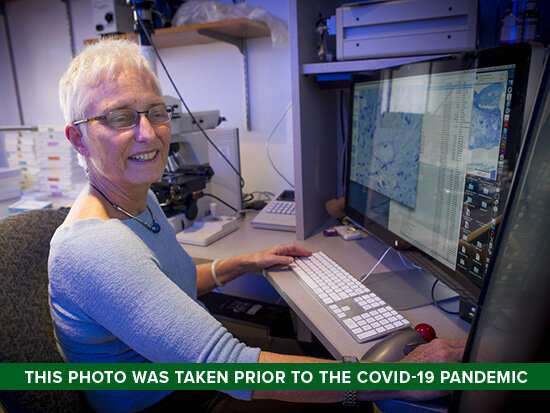
A new study—published in Investigative Ophthalmology and Visual Science from University of Alabama at Birmingham researchers—suggests that linking to a fifth dimension for molecules and affected cells could help define new therapeutic strategies for those suffering from age-related macular degeneration.
Christine A. Curcio, Ph.D., White-McKee Endowed Professor in Ophthalmology with UAB’s Department of Ophthalmology and Visual Sciences, says these findings could open new possibilities for patients with AMD.
“The retina is like the camera chip in a smartphone—it takes pictures for the brain,” she said. “Each light-sensitive photoreceptor sits in a precise location (x,y) and connects to well-organized tissue layers (z). Because the front of the eye is clear, doctors can see retinal layers using optical coherence tomography.”
This clinical tool is a quick and painless imaging test that uses light waves to take pictures of the back of the eye. It is widely used to diagnose and manage age-related macular degeneration. AMD degrades detailed vision in older persons worldwide.
“With OCT, retina changes can be observed over time (t), giving four dimensions (x,y,z,t),” Curcio said. “Linking to a fifth dimension, (m), for molecules in affected cells, could help define new therapeutic strategies.”
Much of the large AMD population currently lacks treatment options.
Curcio said bright spots in optical coherence tomography, called HRF, indicate a “high risk for” advanced AMD.
“In new research, investigators used OCT to watch HRF moving across the retina over months,” Curcio said. “In a microscopic study of tissue specimens, scientists found that HRF corresponded to retinal pigment epithelium, or RPE, cells.”
These cells, which normally support photoreceptors, left their layer, with some contacting remote blood vessels. Further, out-of-place RPE changed their molecular character; they no longer contained proteins needed directly for vision but instead contained proteins used by immune cells. This switch suggests epithelial-mesenchyme-transition. EMT is a well-known molecular process in cancer research.
Source: Read Full Article
